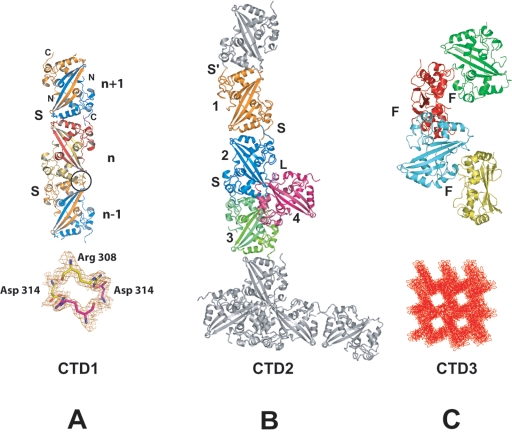FIG. 4.
Crystal-packing interactions between CTD dimers. (A) Crystal-packing interactions in CTD1 crystals grown at pH 4.5, with one dimer in the asymmetric unit (ASU). Three consecutive dimers from the neighboring ASU (numbered n, n + 1, and n − 1) related by one of the three orthogonal 21 screw axes are shown (type-S interaction). Each monomer has been given a different color. The N- and C-terminal ends for the n + 1 are indicated. The salt bridge interaction between dimers n and n − 1 seen in the type-S interface is circled. A closeup view of the salt bridge interaction with an electron density map is shown in the inset below. (B) Interactions between the four CTD dimers present in the CTD2 ASU (pH 8.5). Each dimer is shown in a different color and numbered from 1 to 4. The two classes of dimer-dimer interactions are indicated by S (between molecules 1 and 2 and molecules 2 and 3) and L (between molecules 2 and 4). The bridging type-S′ interactions are shown with molecule 4 from two adjacent ASUs and molecules 1, 2, and 3 from the neighboring ASU (all shown in gray). (C) Dimer-dimer interactions observed in the CTD3 crystals having one CTD dimer in the ASU (type F). Each dimer related by the crystallographic 43 screw axis is shown in a different color. This type of packing gives rise to hollow tubes, as is evident from a projection along the fiber axis (along the c axis) below shown in red.

